Indigenously fan-tastic
Upasana Bhattacharya
As a child growing up in the late 80’s, I fondly remember certain quintessential elements from our middle class Bengali household. The standard haathpakha1 from Shantipur was one of them. Each time there was a power cut in the long summer afternoons, and the cooler stopped working, and Delhi’s heat started to gnaw; it was didan’s2 little haathpakha that would save the day, while dadu3 would once again happily resume his engrossing narrative from the Thakumar Jhuli4 or Tuntunir Boi5. Gradually though, life picked pace, and the haathpakha got lost in oblivion somewhere, wordlessly replaced by the inverter. 
This June however, I happened to see an exhibition at the Twin Art Gallery in IGNCA, which moved me to revere something that I had otherwise taken much for granted. “Pankha”, as this exhibition was simply called, put together by master artist and sculptor Jatin Das; showcasing an abundant collection of indigenous, handcrafted fans from all over India and beyond; was notches above just curatorial brilliance. It was pure, uninhibited passion. And it was contagious.
I have always had this distinctive appreciation for all crafts that come with a bonus of being utilitarian. Because why else did we start making artefacts in the first place? Whether one embroidered layers of old saris to make quilts, or whether one molded pottery for storage, or whether one made hand fans to survive the heat; there was always a strong sense of both beauty and efficacy in these creations. It was this innate intelligence of our forefathers combined with their sharp sense of aesthetics that made such simple yet enticing things possible.
One wonders, could it have been the first humans from the Paleolithic times who may have felt the need for some cool, refreshing breeze when the weather turned spitefully hot? Or could it have been when humans discovered fire and wanted to use some kind of an object to blow the air to keep it alive? The origin of this common artefact is quite uncertain. Nonetheless, the fundamental concept of a portable cooling device must have taken root in the human awareness during the prehistoric era itself, for it may have struck someone to realize that a large leaf or a big bird’s feather if held in hand and waved close to one’s face worked rather well. Fantastic as it is, this basic operating principle still remains the same to this day. Many depictions of hand fans can be seen in art, especially in the sixteenth century French Court. A variety of foldable fans were first seen in Italy in the middle of the sixteen century, probably imported from the Orients by the Venetian merchants.
Read More>> Please Subscribe our Physical Magazine
